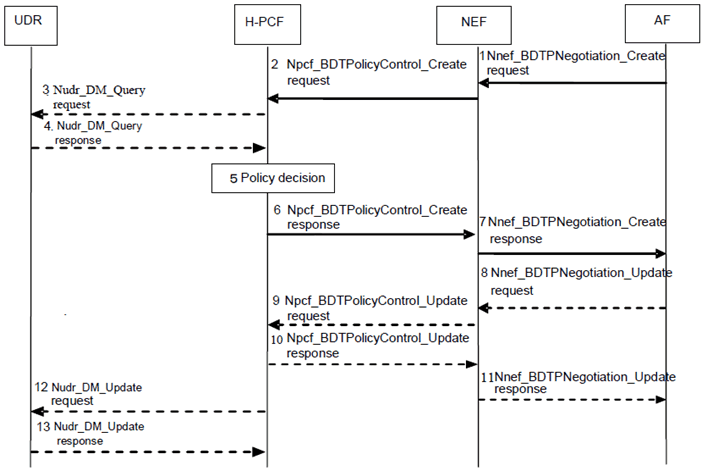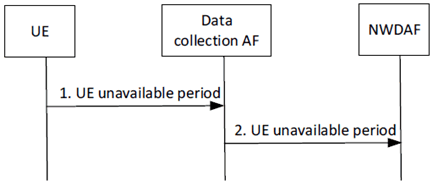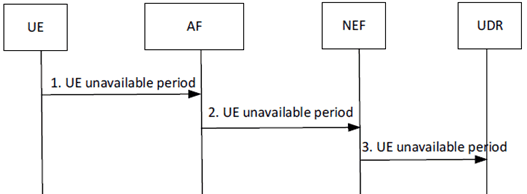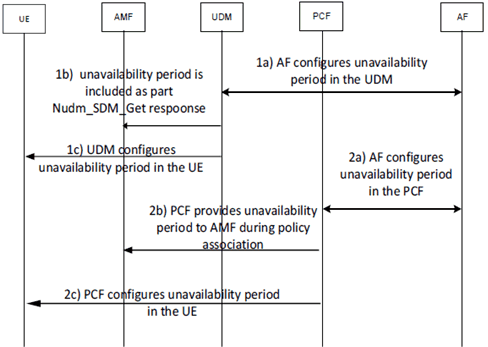Content for TR 23.700-61 Word version: 18.0.0
6.5 Solution #5: Determination of unavailability period in 5GS for a specific UE
6.6 Solution #6: Determination of unavailability period in 5GS for a specific UE
6.5 Solution #5: Determination of unavailability period in 5GS for a specific UE p. 17
6.5.1 Introduction p. 17
This solution aims to solve Key Issue #1 as described in clause 5.1.
6.5.2 Functional Description p. 17
Once the UE has downloaded the binary, the time when the UE performs the upgrade is left for the UE implementation, with possibly UE implementations seeking user input. In order to avoid impact to critical operations which would be executed during the UE unavailable period without prior knowledge from the core network and/or application function, this solution proposes that the UE reports its unavailable period to the network. The network takes the UE unavailable period into account when determining recommended time window for data transfer of the UE.
It is proposed that the NWDAF collects UE unavailable period from the UE via Data Collection AF. The application function negotiates recommended time window using background data transfer procedure. During this procedure, the PCF requests from the NWDAF the UE unavailable period. The PCF determines the recommended time for the application function to avoid the UE unavailable period.
6.5.3 Procedures p. 17
6.5.3.1 Procedures for future background data transfer p. 17
This procedure is performed as per Figure 4.16.7.2-1 Negotiation for future background data transfer in TS 23.502 with the following differences:

In step 1, the AF invokes the Nnef_BDTPNegotiation_Create service and carries a "critical" indication. It indicates that this service is critical and the data transfer shall be performed avoid UE unavailable period.
In step 2, the NEF sends the "critical" indication within the Npcf_BDTPolicyControl_Create message to the H-PCF.
Alternative 1)
In step 5, the H-PCF interacts with the NWDAF using Nnwdaf_AnalyticsSubscription_Subscribe and requests for UE unavailable period for the corresponding UEs.
The NWDAF responds to the H-PCF with UE unavailable period using Nnwdaf_AnalyticsSubscription_Notify .
Alternative 2)
In step 3, the PCF requests UE unavailable period from the UDR.
In step 4, the UDR response to the H-PCF with UE unavailable period.
The H-PCF determines Background Data Transfer policies by taking into account the UE unavailable period.
6.5.3.2 Procedure for NWDAF collects UE unavailable period from the UE p. 18

Step 1.
The NWDAF may subscribe the UE unavailable period from the AF using Naf_
The UE determines its unavailable period. The UE can determine its unavailable period based on UE implementation. The UE sends the UE unavailable period to the Data collection AF. This step reuses the data collection procedure in clause 6.2.8.2.1 of TS 23.288.
Step 2.
The Data Collection AF sends the UE unavailable period to the NWDAF, e.g. using Naf_EventExposure_Notify .
6.5.3.3 Procedure for UDR collects UE unavailable period p. 18

Step 1.
The UDR stores the UE unavailable period and is provided to the PCF as described in clause 6.5.3.1.
The UE determines its unavailable period. The UE can determine its unavailable period based on UE implementation. The UE sends the UE unavailable period to the AF.
Step 2.
The AF sends the UE unavailable period to the NEF, e.g. using Nnef_ParameterProvision_Create .
Step 3.
The NEF sends the UE unavailable period to the UDR.
6.5.4 Impacts on services, entities and interfaces p. 19
For alternative 1):
UE:
For alternative 2):
- Be able to send UE unavailable period to the Data collection AF.
- Be able to send UE unavailable period to the NWDAF.
- Be able to send UE unavailable period to the PCF.
- Be able to request for UE unavailable period from the NWDAF and to take the UE unavailable period into account when determining recommended time window in Background Data Transfer policies.
- Be able to send "critical" indication to the NEF.
UE:
- Be able to send UE unavailable period to the AF.
- Be able to send UE unavailable period to the NEF.
- Be able to send UE unavailable period to the UDR.
- Be able to request for UE unavailable period from the UDR and to take the UE unavailable period into account when determining recommended time window in Background Data Transfer policies.
- Be able to send "critical" indication to the NEF.
6.6 Solution #6: Determination of unavailability period in 5GS for a specific UE p. 19
6.6.1 Introduction p. 19
This is a candidate solution to the key issue#1.
6.6.2 Functional Description p. 20
As described in key issue#1, UEs become unavailable (i.e. cannot interact with the 5G System) in the order of minutes whenever below events (hereafter called as events) are executed:
- Silent reset at Modem;
- Security patch updates;
- OS upgrade;
- Modem SW updates; and
- Device reboot upon Modem setting changes via OMA-DM.
6.6.3 Procedures p. 20

Figure 6.6.2-1: Determination of unavailability period in 5GS for a specific UE
(⇒ copy of original 3GPP image)
(⇒ copy of original 3GPP image)
Option-A:
Step 1a.
Option-B:
By re-using the procedures described in clause 4.15.6.2 of TS 23.502, the AF provisions the unavailability period parameter into the UDM/UDR, or the UDM/UDR can be configured with the unavailability period parameter based on operator policy.
Step 1b.
The unavailability period parameter is provided to AMF by UDM using Nudm_SDM_Get response. Based on the unavailability period, AMF may choose to not initiate procedures which can force UE to enter deregistered state.
Step 1c.
UDM uses the UE Parameters Update via UDM Control Plane Procedure as described in clause 4.20 of TS 23.502 to configure the unavailability period parameter into the UE.
Step 2a.
The unavailability period parameter is the time slot which indicates the time in which UE is allowed to perform deregistration procedure to execute events described in clause 6.6.2. The unavailability period parameter can have multiple time slots for example 10:00-12:00 UTC, 14:00 - 18:00 UTC, 22:00-23:59 UTC etc. If UE is not able to execute the events for example due to the less storage capacity or insufficient battery level in the first time slot then UE should wait for the next time slot to execute the events.
The network takes unavailability period parameter into account to execute Device reboot upon Modem setting changes via OMA-DM procedures.
If UE have a user interface, how UE indicates the unavailability period to the user and take his consent to execute the events during unavailability period is outside the scope of this study as agreed in clause 2.
The unavailability period is configured by the HPLMN, based on agreements with the AF and operator policy, into the UE.
By re-using the procedures described in clause 4.15.6.7 of TS 23.502, AF provisions the unavailability period parameter into the PCF, or the PCF can be configured with the unavailability period parameter based on operator policy.
Step 2b.
The unavailability period parameter is provided to AMF by PCF during AM policy association. Based on the unavailability period, AMF may choose to not initiate procedures which can force UE to enter deregistered state.
Step 2c.
PCF uses the UE Configuration Update procedure for transparent UE Policy delivery as described in clause 4.2.4.3 of TS 23.502 to configure the unavailability period parameter into the UE.
6.6.4 Impacts on services, entities and interfaces p. 21
This solution impacts the following system entities.
UDM or PCF:
- To support provisioning of the unavailability period parameter from the application function which is acceptable to both 5GC and AF.
- To support provisioning of the unavailability period parameter provisioning into the UE.
- To take unavailability period into account to decide whether it can initiate procedures which makes UE enter deregistration procedure.
- To take unavailability period into account to decide whether it can trigger deregistration procedure to execute the events described in clause 6.6.2.